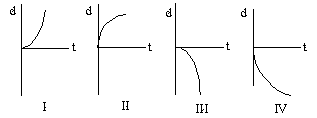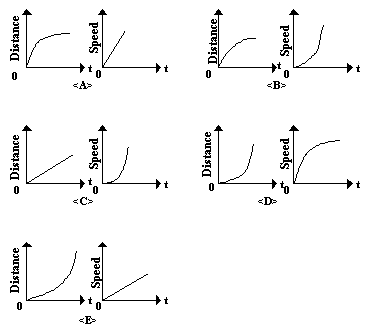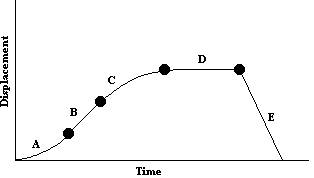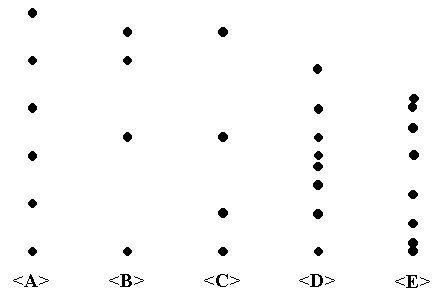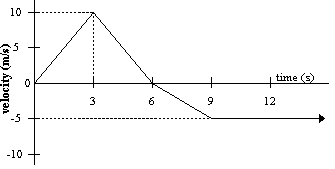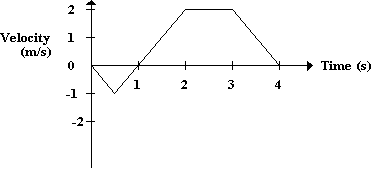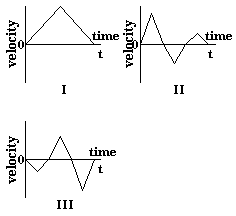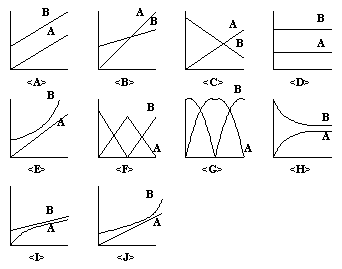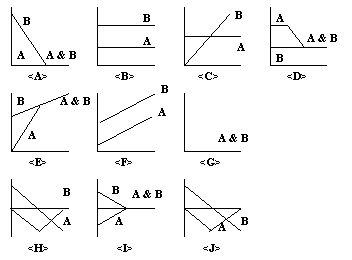1. A ball, initially at
rest at t = 0 seconds, rolls down a
long incline. Since the object is on the incline, its acceleration will be less
than 9.8 m/s2, although the acceleration will still be constant. If
the ball has rolled 1 meter at t = 2
seconds, how far will it have rolled at t
=4 seconds?
A. 2 m
B. 3 m
C. 4 m
D. 5 m
E. 8 m
2. If an object is placed
on a frictionless incline, it will slide down with a constant acceleration.
However, because the object is not falling straight down, this acceleration
will be less than the acceleration due to gravity. Assume specifically that an
object is released from rest on a certain frictionless incline at time t = 0 and that the object slides a
distance of 1 meter during the first second. If the object then keeps on
sliding down this incline with the same acceleration, through what distance
will it travel from t = 1 second to t = 2 seconds.
A. 1 m
B. 2 m
C. 3 m
D. 4 m
E. 5 m
Question 3:
3. The picture above shows
two motorized dynamics carts, A and B, that have been placed on a lab table,
with cart A to the left of cart B. The motors of each cart are turned on
simultaneously and the two carts begin to race towards the right end of the
table with constant accelerations. The front end of cart A and the front end of
cart B reach the right edge of the table at exactly the same time. Which line
in the chart below makes the correct comparison of the average velocity and the
acceleration of cart B with the average velocity and the acceleration of cart
A?
The average velocity of cart B is: The average acceleration of cart B is:
A. less than that of cart A same as
that of cart A
B. greater than that of cart A greater than
that of cart A
C. less than that of cart A less than that of cart A
D. same as that of cart A greater
than that of cart A
E. greater than that of cart A same as that of cart A
4. A scientist is studying
the constant acceleration of three different cars and gets the following
results:
.
Car I changes its speed from v to 2v
in a time interval of t
Car II changes its speed from v to 3v in a time interval of 2t.
Car III changes its speed from
v to 5v in a time interval of 5t.
Which choice below gives the correct relationship between the accelerations of
the three cars?
A. the acceleration of car I = the acceleration
of car II = the acceleration of car III
B. the acceleration of car I > the
acceleration of car II > the acceleration of car III
C. the acceleration of car I < the
acceleration of car II < the
acceleration of car III
D. the acceleration of car I = the acceleration
of car II > the acceleration of car III
E. the acceleration of car I = the
acceleration of car II < the acceleration of car III
Question 5:
5. The picture above shows
the pattern of dots that was made by a tape timer on a strip of ticker tape
connected to a moving object. The tape is oriented so that the first dot that
was made is at the left. Notice that vertical grid lines have been drawn to
help you judge the distances. Which of the following best describes the motion
of the object?
A. The object has a constant velocity
B. The object was speeding up with a constant
acceleration
C. The object is speeding up with a
non-constant acceleration
D. The object is slowing down with a constant
acceleration
E. The object is slowing down with a
non-constant acceleration
Question 6:
6. The picture above shows
the pattern of dots made on ticker
tapes connected to two different moving objects, I and II. Each timer was set
to make the same number of dots per second and each tape is oriented so that
the first dot that was made is at the left. Which of the statements below best
compares the motion of the two objects?
A. Object I has a smaller
initial speed than object II and object I has a smaller average acceleration
than object II
B. Object I has a smaller
initial speed than object II, but object I has a larger average acceleration
than object II
C. Object I has a larger
initial speed than object II, but object I has a smaller average acceleration
than object II
D. Object I has a larger
initial speed than object II and object I has a larger average acceleration
than object II
E. Object I has a smaller
initial speed than object II but both objects have the same average
accelerations.
Question 7:
7. The picture above
represents displacement vs. time for an object moving across a horizontal
surface. Which picture below would most likely represent the pattern of dots
made by a tape timer on a strip of ticker tape that was attached to the object? In each case the tape is oriented so that
the dot on the left is the first dot that was made.
Question 8:
8. A cart is released
from rest at point A of the track shown (reduced in size) in the picture above.
The cart makes dots at a constant rate on a strip of paper laid along the track
as the cart moves from point A to point B. The tape is then removed from the
cart and laid flat. Which of the pictures below would most plausibly represent
the pattern of dots that is made on the tape? In each picture the tape is
oriented so that the first dot that was made is on the left. Vertical guide
lines have also been added to help you gauge the distance between the dots.
Question 9:
9. Each of the three graphs
above represents acceleration versus time for an object that already has a
non-zero positive velocity at time t1.
Which graphs show an object whose speed is increasing for the entire time
interval between t1 and t2?
A. graph I, only
B. graph II, only
C. graphs I and II, only
D. graphs I and III, only
E. graphs I, II, and III
Question 10:
10. Each of the graphs above
shows the displacement, d, as a
function of time for a different moving object. Which graph(s) show an object
that is moving with a positive acceleration?
A. graph I, only
B. graphs I and II, only
C. graph I and III, only
D. graph I and IV, only
E. graph III and IV, only
Question 11:
11. One of the graphs above
shows the displacement of an object as a function of time; another one of the
graphs shows the velocity of that same object as a function of time; and the
remaining graph shows the acceleration of that same object as a function of
time. Which line in the chart below correctly indicates which graph is which?
Disp. vs. Time Vel. vs. Time Accel. vs. Time
A. graph III graph II graph I
B. graph
II graph I graph III
C. graph I graph II graph III
D. graph II graph III graph I
E. graph III graph I graph II
12. Which pair of graphs
below shows the distance traveled versus time and the speed versus time for an
object uniformly accelerated from rest starting at time t = 0?
13. Complete the following
word analogy
acceleration:velocity::
A. distance:displacement
B. displacement:velocitry
C. velocity:displacement
D. displacement:acceleration
E. acceleration:displacement
14. Two balls have been
dropped, at slightly different times, from the top of a very tall office
building. At a certain time the difference between their speeds is 4.0 m/s.
What is the difference between their speeds two seconds later?
A. 4.0 m/s
B. 24.0 m/s
C. 16 m/s
D. 20 m/s
E. 44.0 m/s
15. A hammer and a feather
simultaneously dropped near the surface of the Earth will not keep up with each
other as they fall. However, if this experiment were to be performed on the
surface of the Moon, the hammer and the feather would keep up with each other.
This is best explained by the fact that
A. The air on the Moon is much denser than it
is on the Earth
B. There is no air on the Moon
C. The Moon has no gravity
D. The Moon has gravity, but it is much weaker
than on the Earth
E. The gravity on the Moon is much stronger
than it is on the Earth
Questions
16 to 19 :
Each of these questions refers to the displacement versus time graph
below. The graph describes the motion of a car that was initially heading north
along a straight north-south road. Each of the five labeled intervals on the
graph – A,B,C,D and E – lasts for the same amount of time. North is the
positive direction.
16. Over which interval(s) is
the velocity of the object greater than zero?
A. interval A, only
B. interval B, only
C. interval D, only
D. intervals A, B, and C
E. intervals A, B, C, and D
17. Over which intervals is
there no change in the velocity of the object?
A. intervals A and C, only
B. intervals B, D, and E, only
C. interval D, only
D. interval B, only
E. interval E, only
18. Over which interval does
the object have the greatest average speed?
A. interval A
B. interval B
C. interval C
D. interval D
E. interval E
19. At the end of interval E,
the car is
A. back at its starting point
B. further north of its starting point than it
was at any other time during its trip
C. north of its starting point, but not as far
north as it was at other times during its trip.
D. further south of its starting point than it
was at any other time during its trip.
E. south of its starting point, but not as far
south as it was at other times during its trip.
Questions
20 to 24
Each of these question poses a kinematic problem. Select the one
kinematic equation from the list below that, by itself, can be used to find the
solution; or indicate that there is not enough information to solve the
problem.
I: d = [(V0 + Vf)/2]t
II: Vf = V0
+ at
III: d = V0t + ˝at2
IV: Vf2 - V02 = 2ad
20. Problem: During a period
of constant acceleration a car moves through a distance of 97.8 meters as
its speed changes from
17.6 m/s to 25.2 m/s. For how many seconds did this period of
acceleration last?
Which single one of the above
equations, if any, could be used to solve this problem?
A. equation I
B. equation II
C. equation III
D . equation IV
E. there is not enough information to solve
this problem
21. Problem: An elephant,
initially at rest on a frictionless ice pond, burps and recoils with a constant
acceleration. After it
has moved through a distance of 2.4 meters, its speed is 0.34 m/s.
What was its
acceleration?
Which single one of the above
equations, if any, could be used to solve this problem?
A. equation I
B. equation II
C. equation III
D. equation IV
E. there is not enough information to solve
this problem
22.
Problem: A baseball pitcher throws a fast ball towards home plate at a
speed of 34.1 m/s. What
acceleration
does the ball undergo as it comes to rest in the catcher's mitt?
Which single one
of the above equations, if any, could be used to solve this problem?
A. equation I
B. equation II
C. equation III
D. equation IV
E. there is not enough information to solve
this problem
23. Problem: What
acceleration must a car have if its speed is to change from 11.6 m/s to 16.4
m/s in 3.6
seconds?
Which single one of the above equations, if any, could be used to solve this
problem?
A. equation I
B. equation II
C. equation III
D. equation IV
E. there is not enough information to solve
this problem
24. Problem: How many seconds
will it take a car to travel 45.3 meters if it has an initial velocity of
5.2 m/s and it accelerates at 3.7 m/s2.
Which single one of the
above equations, if any, could be used to solve this problem?
A. equation I
B. equation II
C. equation III
D. equation IV
E. there is not enough information to solve
this problem
25. The speed of an object
one second after it has been dropped from rest out of a high office window on
the planet Mitochondria is 8 m/s. What will its speed be 3 seconds after it was
first dropped?
A. 8 m/s
B. 24 m/s
C. 12 m/s
D. 72 m/s
E. 36 m/s
26. An object is thrown
upward from the ground at sea level on Earth with an initial speed of 30 m/s.
Which of the following is closest to the total time that the object will be in
the air before it strikes the ground again?
A. 2.5 seconds
B. 6.0 seconds
C. 3.0 seconds
D. 5.0 seconds
E. 30 seconds
27. A ball is thrown
vertically up and is caught when it returns to the same vertical position from
which it was thrown. The ball takes 3 seconds to reach its maximum height. For
what total time interval is the ball in the air? Neglect air friction.
A. between 3 seconds and 6 seconds
B. 6 seconds
C. longer than 6 seconds
D. 9.8 seconds
E. 19.6 seconds
28. A ball is thrown
vertically up from the Earth and eventually returns to the same vertical
position from which it was thrown. The motion of the ball can be divided into
three stages: the time interval during which the ball is rising to its maximum
height, the point in time when the ball is at its maximum height, and the time interval
during which the ball is falling back to ground level. Which line in the chart
below gives the correct acceleration of the ball during each of these stages.
Up is consistently being taken as the positive direction.
The Acceleration as The
Acceleration at The
Acceleration as
the Ball Ascends the Highest Point the Ball
Descends
A. +9.8 m/s2 +9.8 m/s2 +9.8 m/s2
B. - 9.8 m/s2 - 9.8 m/s2 - 9.8 m/s2
C. +9.8 m/s2 0 +9.8 m/s2
D. - 9.8 m/s2 0 - 9.8 m/s2
E. +9.8 m/s2 0 - 9.8 m/s2
Questions 29-32:
An alien physics student standing on a table in front of her classroom
on the planet Itsibitsiwitsia throws a ball down with an initial velocity of
-8.0 m/s and lets the ball bounce on the floor. However, the student makes no
attempt to catch the ball on its way back up again, so the ball rises past the
point from which it was thrown. Meanwhile, another student uses a radar gun to
measure the speed of the ball at one‑second time intervals. We will
assume that when the ball first hits the floor it immediately bounces back up
again with the same speed it had when it collided with the floor on the way
down. The chart below shows the student’s data, where zero seconds is the time
when the ball first leaves the girl’s hand and the positive direction is taken
as upwards.
Time (s) Velocity (m/s)
0 -8.0
1 -12.0
2 -16.0
3 +12.0
4 +8.0
5 +4.0
6 0.0
7 -4.0
29. At what time did the ball
return to the height from which it was first thrown?
A. 1 second
B. 2 seconds
C. 4 seconds
D. 6 seconds
E. 7 seconds
30. At what time did the ball
most likely strike the ground?
A. 0 seconds
B. 2 seconds
C. 4 seconds
D. 6 seconds
E. 7 seconds
31. What is the magnitude of
the acceleration due to gravity at the surface of Itsibitsiwitsia?
A. 8.0 m/s2
B. 10.0 m/s2
C. 16.0 m/s2
D. 4.0 m/s2
E. It cannot be determined from the given
information
32. Recall that the girl does
not catch the ball after it bounces back up again. At what time did the ball
reach its maximum height?
A. 3 seconds
B. 4 seconds
C. 5 seconds
D. 6 seconds
E. 7 seconds
33. Three students leaning
over the edge of a cliff each release a ball in a different way
Ball A is dropped
from rest
Ball B is thrown downward with an initial speed
of 10 m/s
Ball C is thrown
upward with an initial speed of 10 m/s
Since the students were leaning over the edge, all three balls (including the
one that was thrown straight up) eventually strike the ground at the base of
the cliff. Which of the five choices below correctly compares the speeds with
which each of the balls strikes the ground?
A. speed of ball A = speed of ball B = speed of
ball C
B. speed of ball B > speed of ball A >
speed of ball C
C. speed of ball B < speed of ball A <
speed of ball C
D. speed of ball A < speed of ball B = speed
of ball C
E. speed of ball A > of ball B = speed of
ball C
34. An astronaut performs an
experiment on the Earth. She throws a ball straight upward with an initial velocity v and measures various aspects of its subsequent motion. The
astronaut plans to repeat the exact
same experiment several days later on the moon. That is, she will throw the
same ball upward at the same initial speed v and perform the same
measurements. Which combination of the three quantities below would be greater
when they are measured on the moon than they were when measured on the Earth?
(Recall that the acceleration due to gravity on the moon is less than it is on
the Earth, but that it is not zero.)
I. the speed of the ball when it returns to the astronauts hand
II. the total time that the ball is in the air
III. the maximum height to which the ball rises
A. I, only
B. II, only
C. I and III, only
D. II and III, only
E. I, II, and III
Question 35:
35. A ball was thrown
vertically upward from the surface of the Earth and the subsequent positions of
the ball were marked off on an adjacent wall at equal time intervals until the
ball reached its maximum height. Which column of dots in the picture above most
likely shows what the positions of the ball were.
A. column A
B. column B
C. column C
D. column D
E. column E
36. Object A is dropped from
the roof of a tall office building and a short while later object B is dropped
from that same roof. At t seconds
after the object B was dropped the two objects have speeds of 20 m/s and 24
m/s. What is the difference between the speeds of the two objects at t + 3 seconds after object B was
dropped?
A. 4 m/s
B. 7 m/s
C. 10 m/s
D. 45 m/s
E. 90 m/s
Questions 37:
Two astronauts are making kinematic observations on an alien planet. One
astronaut throws a ball and, after the ball has left his hand, a second
astronaut uses a radar gun to measure the ball’s velocity at one second
intervals. This data is recorded in the chart below, where zero seconds
represents the time when the astronauts happened to take their first reading and
the direction in which the ball was initially moving is taken as positive.
TIME(s) VELOCITY (m/s)
0 10.5
1 7.0
2 3.5
3 0.0
4 -3.5
5 -7.0
6 -10.5
37. During the interval in
which the astronaut recorded the data the object was most likely
A. only rising vertically upward
B. only falling vertically downward
C. only moving horizontally
D. first rising vertically upward then falling
vertically downward
E. first falling vertically
downward and then, after bouncing off the ground, rising vertically upward
again
38. A physics teacher finds a
scrap of paper on which one of his students has written the following equation:
(0)2 -
(27)2 = 2(-9.8)x
For which of the following problems would this equation be part of the correct
solution?
A. Find the speed of an object 27 seconds after
it was dropped from rest.
B. Find the distance an object has fallen 27
seconds after it was released from rest on Earth.
C. Find the maximum height to which a ball will
rise if it is thrown upward with an initial speed of
27 m/s.
D. Find the distance an object travels if it
accelerates uniformly from rest and reaches a speed of
27 m/s after 9.8 seconds
have elapsed
E. Find the time it takes an object to hit the
ground if it is dropped from a height of 27 meters
39. Two astronauts are
attempting to measure g, the
acceleration due to gravity, on a new planet they have discovered. One
astronaut drops a ball while the other one times the fall. It turns out that
the ball falls through a distance s
in a time interval t. Neglecting air
friction, which of the following expressions for the acceleration due to
gravity on this planet is correct?
A. 
B. 
C. 
D. 
E. 
40. An object was thrown
vertically towards the floor of a physics laboratory on Earth, another object
was thrown vertically towards the floor of a space capsule on the surface of
the Moon, and a third object was thrown straight towards the floor of a space
capsule at rest in outer space, far away from any star or planet. Each of the
objects were connected to ticker tapes that were fed through identical buzzer
timers that had the same settings.
Pictures of the pattern of dots on each tape are given below in random order.

Which line on the chart below
correctly describes which tape was made in which environment?
(Remember that there is gravity on
the moon, although it is less than on Earth; and that there is no
gravity in outer space.)
On the Earth
On the Moon In Outer Space
A. tape I tape II tape III
B. tape III tape I tape II
C. tape III tape II tape I
D. tape I tape
III tape II
E. tape II tape III tape I
Questions 41-43:
Base your answers to questions 41 to 43 on
the graph below which represents velocity versus time for
an object that starts moving in
the positive direction at t=0 seconds.
41. At what time after 0
seconds will the object first return to its starting point?
A. 3 seconds
B. 6 seconds
C. 9 seconds
D. 12 seconds
E. sometime after 12 seconds
42. At what time shown on the
graph does the object first begin to reduce its speed?
A. 0 seconds
B. 3 seconds
C. 6 seconds
D. 9 seconds
E. 12 seconds
43. At what time after 0
seconds does the object first begin to travel southward?
A. 0 seconds
B. 3 seconds
C. 6 seconds
D. 9 seconds
E. 12 seconds
Question 44:
44. The graph above shows the
velocity versus time for an object
moving in a straight line. At what time after t = 0 does the object again pass through its initial position at
zero seconds?
A. Between 0 and 1 s
B. 1 s
C. between 1 and 2 s
D. 2 s
E. Between 2 and 3 s
Question 45:
45. Each of the three graphs
shown above represents the velocity as a function of time for an object that is
moving back and forth along a straight line during the time interval from zero
seconds to t seconds. Which of these
graphs describe a motion during which the object returns to its position at
zero seconds at some subsequent time during the interval being shown?
A. II, only
B. III, only
C. II and III, only
D. I and II, only
E. I, II, and III
Questions 46-50:
Each graph below
represents the motion of two different objects. Each question in this group asks you to choose one of these
graphs as your answer.
46. Car A is heading North
and car B is heading South along the same narrow street. At the last minute the
driver of each car slams on the brakes and a head‑on collision is
narrowly averted. Which of the above graphs best represnts displacement as a
function of time for each car? (North is being taken as the positive direction
and both displacements are measured from the location of car A at zero
seconds.)
47. Commuter A is running at
a constant speed towards bus B which is picking up passengers at a stop that is
several meters north of her. However, before she reaches the bus stop, the bus
starts moving north with a constant acceleration and the commuter continues to
chase the bus at the same speed that she had been maintaining before the bus
began to move. Unfortunately, the commuter is not able to catch the bus. Which
of the above graphs best represents displacement as a function of time for both
the commuter and the bus? (North is being taken as the positive direction and
both displacements are measured from the location of the commuter at zero
seconds.)
48. Ball A is thrown into the
air, reaches its maximum height, and falls back down again. At the same
time, ball B is thrown downwards from
above the ground, bounces off the ground with the same speed it had just before
it struck the ground, and returns to its original height. Which of the above
graphs best represents displacement as a function of time for each ball? (Up is
being taken as the positive direction and both displacements are measured from
the height of ball A at zero seconds.)
49. Car A and car B are
travelling north along a one lane road . Car A is behind car B, but car A is
initially moving with a greater speed than car B. As car A approaches car B, it slows down to the same speed as car
B and tailgates car B very closely. Which graph above best represents
displacement as a function of time for each of the graphs? (North is being
taken as the positive direction and both displacements are measured from the
location of car A at zero seconds.)
50. Elm tree A is 30 meters
north of your house and maple tree B is 60 meters north of your house. Which of
the above graphs best represents displacement as a function of time for each
tree? (North is being taken as the positive direction and both displacements
are measured from the location of your house.)
Questions 51-55:
Each graph below represents the motion for two different objects. Each
question in this group asks you to choose one of these graphs as your answer.
51. Car A is heading North
and car B is heading South along the same narrow street. At the last minute the
driver of each car slams on the brakes and a head on collision is narrowly
averted. Which of the above graphs best represents velocity as a function of
time for each of the graphs? (North is being taken as the positive direction.)
52. Commuter A is running at
a constant speed towards bus B which is picking up passengers at a stop that is
several meters north her. However, before she reaches the bus stop, the bus
starts moving north with a constant acceleration and the commuter continues to
chase the bus at the same speed that she had been maintaining before the bus
began to move. Unfortunately, the commuter is not able to catch the bus. Which
of the above graphs best represents velocity as a function of time for both the
commuter and the bus? (North is being taken as the positive direction.)
53. Ball A is thrown into the
air, reaches its maximum height, and falls back down again. At the same
time, ball B is thrown downwards from
above the ground, bounces off the ground with the same speed it had just before
it struck the ground, and returns to its original height. Which of the above
graphs best represents velocity as a function of time for each ball? (Up is
being taken as the positive direction.)
54. Car A and car B are
travelling north along a one lane road . Car A is behind car B, but car A is
initially moving with a greater speed than car B. As car A approaches car B, it slows down to the same speed as car
B and tailgates car B very closely. Which graph above best represents velocity
as a function of time for each car? (North is being taken as the positive
direction.)
55. Elm tree A is 30 meters
north of your house and maple tree B is 60 meters north of your house. Which
graph above best represents velocity as a function of time for each tree?
(North is being taken as the positive direction.)
ANSWER KEY
1. C 31. D
2. C 32. D
3. C 33. D
4. D 34. D
5. B 35. B
6. B 36. A
7. B 37. D
8. A 38. C
9. E 39. E
10. D 40. B
11. A 41. E
12. E 42. B
13. C 43. C
14. A 44. C
15. B 45. B
16. D 46. H
17. B 47. E
18. E 48. G
19. A 49. I
20. A 50. D
21. D 51. I
22. E 52. C
23. B 53. H
24. C 54. D
25. B 55. G
26. B
27. B
28. B
29. C
30. B








